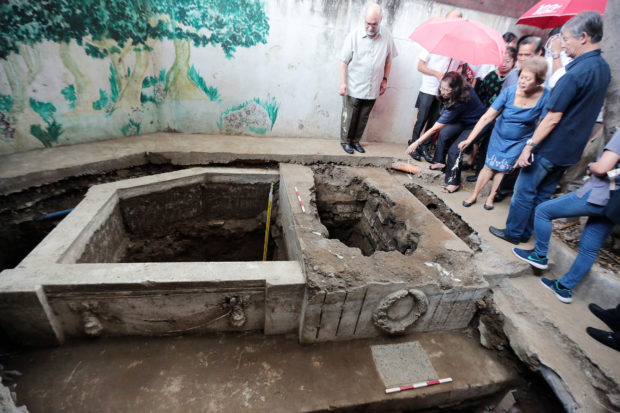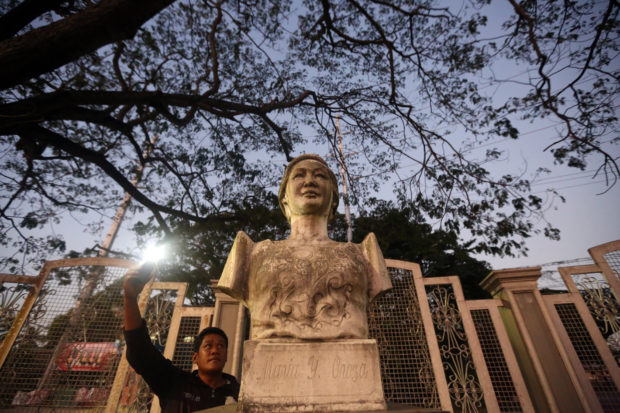Grave marker revives interest in WWII heroine Maria Orosa

FRESH APPRECIATION Descendants of Maria Orosa pay respects at the site where a grave marker
bearing her name was recently found at the campus grounds of Malate Catholic School in Manila.
A bust of Orosa can be found in Batangas City. —MARIANNE BERMUDEZ/GRIG C. MONTEGRANDE
MANILA, Philippines — Last Thursday, Feb. 13, marked the 75th death anniversary of Maria Orosa, a food scientist who used her expertise to save lives during World War II but whose life story is seldom retold.
But decades after the end of the war, efforts to locate Orosa’s remains — and celebrate her heroism — are gaining fresh momentum, with the recent discovery of a grave marker bearing her name.
The conflict’s horrific finale in the Philippines, the Battle for Manila was the monthlong campaign by US forces, beginning Feb. 3, 1945, to liberate the capital. The cost was steep — the mass slaughter of some 100,000 civilians in the hands of the retreating Japanese, as American troops advanced.
Although Orosa was right in the thick of this grim action, she died under different but still terrible circumstances. According to a September 2018 Inquirer article by Norma Chikiamco, as well as other accounts, she was hit by shrapnel at the Bureau of Plant Industry where she worked.
She was rushed to nearby Remedios Hospital, but amid the bombardment in the Malate district, another fragment hit her, this time piercing her heart.
Article continues after this advertisementThe Malate Church had a Mass on Thursday to commemorate the Remedios Hospital bombing. In an interview with the Inquirer, Apolinario Orosa, a nephew of the patriot, noted the irony of her demise: that she supplied food to detained American troops at the University of Santo Tomas, “[a]nd yet it was an American shell that killed her.”
Article continues after this advertisementOrosa was honored in the postwar era by the renaming of Calle Florida (one of several streets named after US states) in her honor. In the Ermita district, Orosa Street begins at Burgos Avenue and ends at Padre Faura. The important landmarks here, among others, are the Philam Life Building and the Court of Appeals.
The Malate side of Orosa street begins at Pedro Gil and ends at San Andres Street. It was in this area where Orosa’s pioneering work was based—as she headed the Bureau of Plant Industry—and it was here where she died.Well-rounded, well-dressed
“She was an icon long before the term became a descriptive noun,” Chikiamco wrote, describing Orosa “as a chemist, pharmacist, food scientist, humanitarian, and above all, a freedom fighter and a war heroine.”
Orosa, however, was not all seriousness. Apolinario, 93, remembers his aunt as a well-dressed woman who always wore shiny shoes and brand new outfits, and as one the few women drivers in the city during her time.
On the other hand, Orosa’s chosen fields were far away removed from glamor and were more in step with the spirit of nation-building of her era. Her expertise certainly proved critical during that trying chapter of the Occupation.
A significant part of Orosa’s life story was her impressive educational background — particularly her studies abroad where she earned degrees in pharmaceutical chemistry and food chemistry as well as a master’s degree in pharmacy.
Banana ketchup inventor
Upon her return to the Philippines, Orosa “pioneered in food preservation, developed wines using local fruits, created vinegar from pineapple, jelly from guava and developed banana starch and cassava flour,” wrote Chikiamco.
“In fact, it was Maria Y. Orosa who invented the now famous banana ketchup. She also invented a clay pot oven so women in barrios without electricity could also bake, and established the Home Makers Association of the Philippines.”
Orosa joined the guerrilla forces during the war, but her contribution in the war effort was more humanitarian.
“Among other things, she smuggled food to the prisoners of war and to the American civilians interned at University of Santo Tomas,” wrote Chikiamco. “It was this food that kept many prisoners from starving, and surely helped boost their morale.”
During the Battle for Manila, Orosa “ignor[ed]…pleas from her family to leave” the capital. She said soldiers did not abandon their posts.
This “one big adventure” of a life, as Chikiamco described it, has regained a fresh appreciation in our time (as well as a Google image on Nov. 29, her birth anniversary, last year) amid efforts to recover her remains and those of others who perished in the Liberation.
It was reported early this month that a grave marker on the heroine’s remains was found at Malate Catholic School, formerly Remedios Hospital, by a team locating a mass grave at the campus grounds.
On the marker is Orosa’s name, followed by the dates of her birth and death (Nov. 29, 1893 – Feb. 13, 1945), then a brief but poignant tribute that she “Died in line of duty.”
Experts, however, could not yet confirm where Orosa was buried exactly. One theory goes that she was buried in a “mass grave” at a vacant lot at the corner of Remedios and Mabini Streets, a few steps away from the school.
According to historian Matthew Westfall — one of the private individuals who initiated this project to locate Orosa and others missing among those who perished in the Battle for Manila — the marker could have been part of a memorial that was moved from that vacant lot after it was sold recently.
“They did not realize the significance of it. [The memorial] got covered over by subsequent renovations and it [became] basically a pile of rubble. At that point I went to do a little research and find out the names of the people [whose names were on the marker],” Westfall told the Inquirer in an interview.
Westfall himself had a relative, Nikolai Prokopoff (described by various reports as an uncle or grand-uncle), who may be buried either in the school grounds or at the corner lot. He also keeps in touch with relatives of the other missing dead.
‘Fitting memorial’
The idea, according to Westfall, was to bury the bodies in a new memorial fitting for their sacrifice. The dead’s survivors are considering putting up a new memorial on one side of Malate Church.
Yet despite historical accounts pointing to the location of Orosa’s remains, Westfall said: “She may never be found. Assuming she is in a mass grave with several hundred bodies, it’s gonna be hard to extricate that. But what we can do, perhaps, is find out with high degree of certainty that she is in the second mass grave.”
The project to locate the dead is aided by the University of the Philippines’ Archaeology Studies Program, as well as experts such as forensic pathologist Raquel Fortun and noted archaeologist Zandro Villanueva.
“We’ll take it as far as we can go scientifically and then at some point we just have to accept that war is war and we can only find so much,” Westfall said of the project.
“Is it worth opening it up and digging everything? Probably not. We’ll probably leave them there and put up a fitting memorial [for] someone like a war heroine and scientist and food technologist like Maria Orosa. She deserves that.”
